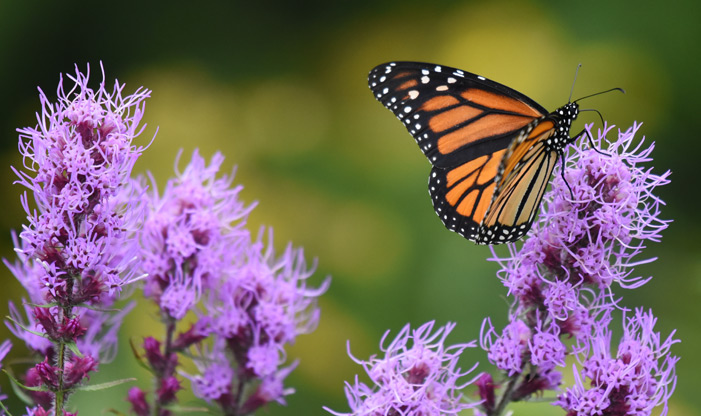In Milwaukee, peak Monarch Butterfly migration happens every year in early September. Monarchs will begin their journey from their northern breeding grounds back to Mexico for the winter. However, the story is much more complicated when you consider the whole process. To understand the entire cycle, begin in Mexico at the Transvolcanic Belt, where the butterflies spend the winter.
Monarchs are important for a number of reasons. As they sip nectar, they are pollinators to wildflowers. Monarchs are a great food source for birds and other insects as well. Their health is directly related to the health of the ecosystem. They are sensitive to pesticides in larval and adult stages, as well as changes in climate and habitat loss. Scientists study Monarchs to learn about these conditions in the environment.
Flying to Mexico
Peak migration in Milwaukee is generally from September 3-15. Emerged Monarchs who migrate south from Wisconsin are part of a generation that will fly over 3,000 miles and have an eight-nine month lifespan within which to make it back to the Michoacán Mountains. These butterflies enter reproductive diapause when they emerge, which allows them to conserve energy for their flight to Mexico. It also means that they don’t reproduce until later.
They reach Mexico close to the Day of the Dead in early November. Some cultures believe the Monarchs, or mariposas, to be the souls of ancestors returning home. When they reach their destination, the Monarchs will overwinter in groups in the tops of Oyamel Fir trees. The Monarchs will stay there until spring, when they leave reproductive diapause, becoming sexually mature. They will migrate some distance northward, lay eggs, and perish.
Migrating North
Now the new generation of Monarchs will begin their multi-generational migration northward. These shorter-lived Monarchs have a two-six week lifespan and travel only part of the way to their destination. The first generation of the shorter-living Monarchs only make it as far as the southern U.S. During this leg of the journey, the butterflies lay as many eggs as possible: one adult may lay up to 100 eggs.
It takes three generations to reach their breeding grounds in the northern U.S. On their journey, they lay their eggs exclusively on milkweed and then perish. Each subsequent generation continues north, the cycle repeating until the Monarchs reach their destination.
Monarchs at the Center
The Monarchs will spend the summer at Schlitz Audubon and other suitable habitats throughout the region. They are here to breed and gather fuel for the long migration back to Mexico. Prairie flowers at the Center, such as Ironweed and Joe Pye Weed, sunflowers, and coneflowers provide this necessary fuel.
During summer, if you look at the leaves of the milkweed plant, you may find Monarch eggs living on them. The eggs will eventually hatch and a caterpillar will emerge. The green and yellow striped caterpillar, or instar, will feast on milkweed, grow from its first instar of 2-6mm, and molt five times to its fifth instar of 25-45mm during a span of 10-14 days. It will then begin its next transformation in which it becomes a chrysalis.
The chrysalis also transforms through its growth cycle, beginning a bright green color and becoming clear before it opens up, when you can actually see the colors of the butterfly’s curled up wings nested inside. The chrysalis form exists for about 10-14 days, after which the chrysalis splits open and a fully formed Monarch butterfly emerges!
During fall migration, the population of Monarchs is the greatest. They add color to the world, but they are more than just pretty. Monarchs are like a barometer to our ecosystem, helping wild flowers survive and alerting people to changes in the environment.


